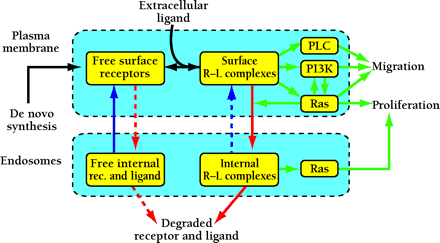
- Institution: Stanford Univ Med Ctr Lane Med Lib/Periodical Dept/Rm L109
- Sign In as Member / Individual
Localization of Receptor-Mediated Signal Transduction Pathways: The Inside Story

Integrated model of RTK regulation and signaling. Signal transduction hinges on the number of active receptors and their compartmentalization over time. Both are subject to receptor trafficking processes. Dashed arrows signify processes that occur at slower rates per receptor in normal cells; however, these processes become increasingly significant as the number of receptors increases, with saturation of the internalization and endosomal retention mechanisms. In addition to regulating the total number of receptors, trafficking processes may bias the specificity of receptor signaling. Surface receptors activate the PLC, PI3K, and Ras–Erk pathways, stimulating both cell migration and proliferation. The Ras–Erk and PI3K pathways engage in crosstalk interactions in both directions, and some of these may only manifest themselves at the plasma membrane, reinforcing cell motility signaling. Internalized receptors can activate the Ras–Erk pathway to extend the duration of cell proliferation signals. Interestingly, activated Ras can enhance receptor internalization through the GTPase Rab5 [reviewed in (22)], providing a negative feedback loop mediating receptor downregulation and a regulatory mechanism governing the balance of cell migration and proliferation signaling.


